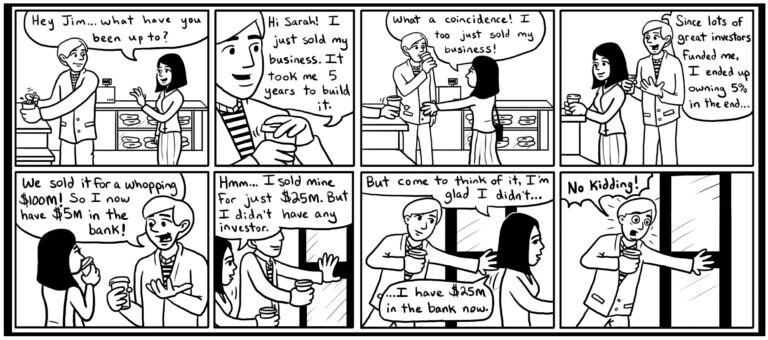Non-Technical Founders Building a Venture Scale SaaS Company: Sendoso CEO Braydan Young (Part 5)
Sramana Mitra: When you made that decision to bring in an enterprise, you were feeling this tension. Did you add to enterprise customers?
Braydan Young: We added.
Sramana Mitra: I thought that’s what you would be doing. People want more enterprise customers.
Braydan Young: We looked at churn. We could look and see who’s doing the sending in the platform. Mid-market enterprises were consistent senders. They would send all the time. You can close SMB faster, but they can’t influence your roadmap.
>>>Featured Videos
614th Roundtable Spotlighting Women Entrepreneurs Starting NOW: Live Tweeting by @1Mby1M
Today’s 614th FREE online 1Mby1M Roundtable for Entrepreneurs is starting NOW, on Thursday, August 3, at 8 a.m. PDT/11 a.m. EDT/5 p.m. CEST/8:30 p.m. India IST. CLICK HERE to join. MEETING NUMBER: 2553 231 4090 PASSWORD: startup All are welcome!
614th Roundtable for Entrepreneurs Starting in 30 Minutes: Live Tweeting by @1Mby1M
Today’s 614th FREE online 1Mby1M Roundtable for Entrepreneurs is starting in 30 minutes, on Thursday, August 3, at 8 a.m. PDT/11 a.m. EDT/5 p.m. CEST/8:30 p.m. India IST. CLICK HERE to join. MEETING NUMBER: 2553 231 4090 PASSWORD: startup All are welcome!
Video FAQs
Can 1M/1M Help Me Raise Money?
How Does 1M/1M Democratize Entrepreneurship Education?
How Does 1M/1M Democratize Management Consulting?
When Is The Right Time To Join 1M/1M?
Can 1M/1M Help Me With Business Development?
Can 1M/1M Help Me With Market Sizing?
Can 1M/1M Help Me Validate My Product?
Will I Have Private 1-on-1 Sessions In 1M/1M?
How Does 1M/1M Help Entrepreneurs Connect With Silicon Valley?
Mentoring or Consulting?
Why Does 1M/1M Charge $1000 a Year?
Why Does 1M/1M Partner With Local Organizations?
Why Don\’t Mentoring Networks Work?
Why Is It Important To Study With 1M/1M Now?
Dan Stewart Story
Vikrant Mathur Story
Non-Technical Founders Building a Venture Scale SaaS Company: Sendoso CEO Braydan Young (Part 4)
Sramana Mitra: The reality is that you were in revenue when you went out to raise. That makes things a lot simpler. The fact that you spent a year fine-tuning your model to the point where you were a recurring revenue-generating business makes raising money a lot simpler.
Braydan Young: The one thing going against us was that we were both salespeople. A lot of the questions were about our technical co-founder.
>>>1Mby1M Udemy Courses with Sramana Mitra: For Educators

For educators and people who want to build thriving communities of entrepreneurs, we have designed a couple of courses that give a roadmap.
>>>Best of Bootstrapping: Bootstrapped with Energy, Smarts, and Execution

If you haven’t already, please study our Bootstrapping Course and Investor Introductions page.
Sylvana Caridi, Founder & CEO of Gravity Pro, has an aura of no nonsense, no bs confidence about her that I find immensely attractive. Read her story to feel the force of sheer energy, smarts, and execution to learn how she did it!
Sramana Mitra: Let’s start by introducing our audience to yourself as well as Gravity Pro.
Sylvana Caridi: I’m 42. I was born and raised in France. My parents were from Italy. They moved from Italy to France to find work because, at that time, it was hard for them because they were both illiterate. I was the last kid and grew up in a very low-class environment. I studied all the way to my doctorate, but I did not do my thesis because I went to work.
Looking for 1Mby1M Ambassadors to Scale Our Work Globally

Friends,
Many of you have responded to our collaboration requests on LinkedIn.
Many of you have reached out to us independently, wanting to add value to the work we do in developing the tech entrepreneurship pipeline around the world.
We are now much better equipped to harness your desire to contribute in a concrete way.
>>>Non-Technical Founders Building a Venture Scale SaaS Company: Sendoso CEO Braydan Young (Part 3)
Sramana Mitra: To me, calling sounds like a mistake.
Braydan Young: Yes. It would have been way better to have a marketing campaign or have a landing page. The knowledge I had was only coming from sales back then. It was brute force.
Sramana Mitra: Unless there is a substantial deal size of at least $10,000 or so, calling doesn’t really work.
>>>